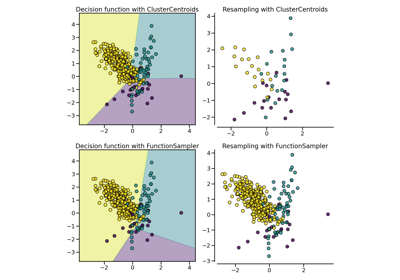EditedNearestNeighbours#
- class imblearn.under_sampling.EditedNearestNeighbours(*, sampling_strategy='auto', n_neighbors=3, kind_sel='all', n_jobs=None)[source]#
Undersample based on the edited nearest neighbour method.
This method cleans the dataset by removing samples close to the decision boundary. It removes observations from the majority class or classes when any or most of its closest neighours are from a different class.
Read more in the User Guide.
- Parameters:
- sampling_strategystr, list or callable
Sampling information to sample the data set.
When
str, specify the class targeted by the resampling. Note the the number of samples will not be equal in each. Possible choices are:'majority': resample only the majority class;'not minority': resample all classes but the minority class;'not majority': resample all classes but the majority class;'all': resample all classes;'auto': equivalent to'not minority'.When
list, the list contains the classes targeted by the resampling.When callable, function taking
yand returns adict. The keys correspond to the targeted classes. The values correspond to the desired number of samples for each class.
- n_neighborsint or object, default=3
If
int, size of the neighbourhood to consider for the undersampling, i.e., ifn_neighbors=3, a sample will be removed when any or most of its 3 closest neighbours are from a different class. If object, an estimator that inherits fromKNeighborsMixinthat will be used to find the nearest-neighbors. Note that if you want to examine the 3 closest neighbours of a sample for the undersampling, you need to pass a 4-KNN.- kind_sel{‘all’, ‘mode’}, default=’all’
Strategy to use to exclude samples.
If
'all', all neighbours should be of the same class of the examined sample for it not be excluded.If
'mode', most neighbours should be of the same class of the examined sample for it not be excluded.
The strategy
"all"will be less conservative than'mode'. Thus, more samples will be removed whenkind_sel="all", generally.- n_jobsint, default=None
Number of CPU cores used during the cross-validation loop.
Nonemeans 1 unless in ajoblib.parallel_backendcontext.-1means using all processors. See Glossary for more details.
- Attributes:
- sampling_strategy_dict
Dictionary containing the information to sample the dataset. The keys correspond to the class labels from which to sample and the values are the number of samples to sample.
- nn_estimator object
Validated K-nearest Neighbours instance created from
n_neighborsparameter.- sample_indices_ndarray of shape (n_new_samples,)
Indices of the samples selected.
Added in version 0.4.
- n_features_in_int
Number of features in the input dataset.
Added in version 0.9.
- feature_names_in_ndarray of shape (
n_features_in_,) Names of features seen during
fit. Defined only whenXhas feature names that are all strings.Added in version 0.10.
See also
CondensedNearestNeighbourUndersample by condensing samples.
RepeatedEditedNearestNeighboursUndersample by repeating the ENN algorithm.
AllKNNUndersample using ENN with varying neighbours.
Notes
The method is based on [1].
Supports multi-class resampling. A one-vs.-rest scheme is used when sampling a class as proposed in [1].
References
Examples
>>> from collections import Counter >>> from sklearn.datasets import make_classification >>> from imblearn.under_sampling import EditedNearestNeighbours >>> X, y = make_classification(n_classes=2, class_sep=2, ... weights=[0.1, 0.9], n_informative=3, n_redundant=1, flip_y=0, ... n_features=20, n_clusters_per_class=1, n_samples=1000, random_state=10) >>> print('Original dataset shape %s' % Counter(y)) Original dataset shape Counter({1: 900, 0: 100}) >>> enn = EditedNearestNeighbours() >>> X_res, y_res = enn.fit_resample(X, y) >>> print('Resampled dataset shape %s' % Counter(y_res)) Resampled dataset shape Counter({1: 887, 0: 100})
Methods
fit(X, y, **params)Check inputs and statistics of the sampler.
fit_resample(X, y, **params)Resample the dataset.
get_feature_names_out([input_features])Get output feature names for transformation.
Get metadata routing of this object.
get_params([deep])Get parameters for this estimator.
set_params(**params)Set the parameters of this estimator.
- fit(X, y, **params)[source]#
Check inputs and statistics of the sampler.
You should use
fit_resamplein all cases.- Parameters:
- X{array-like, dataframe, sparse matrix} of shape (n_samples, n_features)
Data array.
- yarray-like of shape (n_samples,)
Target array.
- Returns:
- selfobject
Return the instance itself.
- fit_resample(X, y, **params)[source]#
Resample the dataset.
- Parameters:
- X{array-like, dataframe, sparse matrix} of shape (n_samples, n_features)
Matrix containing the data which have to be sampled.
- yarray-like of shape (n_samples,)
Corresponding label for each sample in X.
- Returns:
- X_resampled{array-like, dataframe, sparse matrix} of shape (n_samples_new, n_features)
The array containing the resampled data.
- y_resampledarray-like of shape (n_samples_new,)
The corresponding label of
X_resampled.
- get_feature_names_out(input_features=None)[source]#
Get output feature names for transformation.
- Parameters:
- input_featuresarray-like of str or None, default=None
Input features.
If
input_featuresisNone, thenfeature_names_in_is used as feature names in. Iffeature_names_in_is not defined, then the following input feature names are generated:["x0", "x1", ..., "x(n_features_in_ - 1)"].If
input_featuresis an array-like, theninput_featuresmust matchfeature_names_in_iffeature_names_in_is defined.
- Returns:
- feature_names_outndarray of str objects
Same as input features.
- get_metadata_routing()[source]#
Get metadata routing of this object.
Please check User Guide on how the routing mechanism works.
- Returns:
- routingMetadataRequest
A
MetadataRequestencapsulating routing information.
- get_params(deep=True)[source]#
Get parameters for this estimator.
- Parameters:
- deepbool, default=True
If True, will return the parameters for this estimator and contained subobjects that are estimators.
- Returns:
- paramsdict
Parameter names mapped to their values.
- set_params(**params)[source]#
Set the parameters of this estimator.
The method works on simple estimators as well as on nested objects (such as
Pipeline). The latter have parameters of the form<component>__<parameter>so that it’s possible to update each component of a nested object.- Parameters:
- **paramsdict
Estimator parameters.
- Returns:
- selfestimator instance
Estimator instance.



